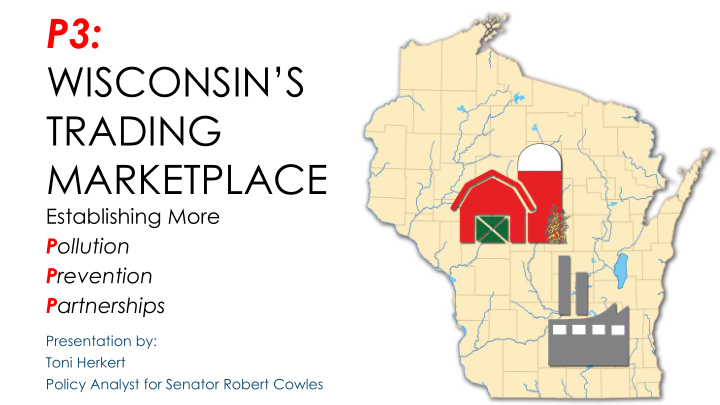



P3: WISCONSIN’S TRADING MARKETPLACE Establishing More P ollution P revention P artnerships Presentation by: Toni Herkert Policy Analyst for Senator Robert Cowles
BACKGROUND ON SENATOR COWLES State Senator for the 2 nd District covering portions of Brown, Outagamie, Shawano, and Waupaca Counties in Northeast Wisconsin Chair, Natural Resources and Energy Co-Chair, Joint Legislative Audit Committee Member, Transportation, Veterans and Military Affairs Member, Speaker’s Task Force on Water Quality Strong focus on natural resource issues and issues related to government accountability and transparency
MULTI-DISCHARGER VARIANCE LEGISLATION One ‘tool in the toolbox’ championed by Senator Cowles to assist point sources that otherwise need expensive infrastructure upgrades to comply with more stringent phosphorus discharge standards. 2013 Wisconsin Act 378 and 2015 Wisconsin Act 205 allow affected sources that cannot meet current discharge limits without making major facility upgrades to seek a determination of infeasibility from DOA regarding the impact from the expense of the required upgrades. If a determination of infeasibility is granted, the discharger will pay $50 per pound of phosphorus into nonpoint remediation account or distribute to certain projects as they work to come into compliance with new phosphorus discharge limits over the course of twenty years. With payments made by the affected source, county conservationists, the discharger, or a third party may implement nonpoint source mitigation project to achieve the same water quality goals.
P3 2019 Senate Bill 91 Introduced on March 13th Natural Resources & Energy Committee Action – Substitute Amendment 1 – Passed 5-0 on March 27 th Passed the Senate on a Voice Vote on May 15 th 2019 Assembly Bill 113 Introduced on March 22nd Heard by the Assembly Committee on Local Government on June 19 th – Awaiting Executive Action Another ‘tool in the toolbox’ to help point sources comply in a more economical manner with more stringent discharge standards while also benefiting nonpoint sources and water quality
P3 MAIN PROVISIONS Retains the existing water quality trading program which allows a WPDES permit holder to marginally increase a pollutant discharge in their permit if they purchase credits from a point source and adds two new options for facilitating trades from: (1) a statewide clearinghouse, or; (2) another third-party broker, certified by the DNR. The clearinghouse will have a contract with DOA approved by the DNR, and third-party brokers will need to have approval from the DNR to begin operating. The clearinghouse would become the statewide broker and the credit bank, responsible for the management of buying and selling water pollution credits and maintaining a registry of credits from all third-party operators in the state. The clearinghouse will develop and maintain an online platform to provide information on the location of potential buyers, available credits, and other information that will facilitate credit transactions.
P3 MAIN PROVISIONS, cont. Credits are produced through practices by nonpoint sources and developed through technology tables and modeling which is reviewed and approved by the DNR. The production and purchase of credits must result in an improvement in water quality. To help ensure a benefit to water quality is achieved, credits are generated at a ratio of 1.0 credit of increased pollution from a point-source to a minimum reduction of 1.2 credits of reduced nonpoint-source pollution. NOTE: Depending on the specific practice, greater ratios may be required to account for uncertainty. Pollutants traded must involve the same pollutant and occur within the same hydrologic area (similar to a watershed) as established by the DNR, typically for the course of a WPDES permit cycle.
P3 MAIN PROVISIONS, cont. Requires the clearinghouse to establish a maintenance schedule for credits and to verify credits with the DNR, subject to a DNR 45 day review prior to making the credits available for sale. Hold harmless clause – the bill specifies that if the clearinghouse ceases to function, the DNR will continue to administer all credits that are in effect until a new clearinghouse is established or contracts expire. Directs the DNR to consult with the EPA regarding the possibility of allowing long-term or permanent credits in more situations than currently allowed in areas subject to an EPA-approved total maximum daily load (TMDL). Finally, this legislation requires the DNR to evaluate the clearinghouse within 4 years.
P3 COLLABORATION Over 50 bipartisan co-authors Over 40 appearances or registrations in-favor at legislative hearings Over 30 groups registered in-favor of the P3: Wisconsin’s Trading Marketplace legislation on the Wisconsin Ethics Commission Eye on Lobbying website
P3 Support – Representing Diverse Interest Groups
EPA Looks to Advance Water Quality Trading
FOR MORE INFORMATION Visit legis.wisconsin.gov and type in ‘SB91’ or ‘AB113’ in the search bar under ‘Law and Legislation’ Visit legis.wisconsin.gov/senate/02/cowles to review this PowerPoint (under the ‘Legislation’ tab) or sign -up for Senator Cowles’ periodic ‘Updates from the State Senate’ e -newsletter Follow Senator Rob Cowles on Facebook, Twitter (@SenRobCowles), or Instagram (@SenRobCowles) Call Toni at (608) 266-0484 or send an email to Toni.Herkert@legis.wisconsin.gov ANY QUESTIONS?
Recommend
More recommend